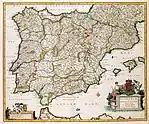Battle of Linuesa
The Battle of Linuesa was an action fought on 21 December 1361 in the municipality of Huesa, Jaén, Spain (contemporary Kingdom of Jaén. The battle was fought between the Kingdom of Castile and the forces of the Emirate of Granada. The battle resulted in a victory for the forces of the Kingdom of Castile.
| Battle of Linuesa | |||||||
|---|---|---|---|---|---|---|---|
| Part of the Reconquista | |||||||
 Map of the Nasrid Emirate of Granada. | |||||||
| |||||||
| Belligerents | |||||||
|
|
| ||||||
| Commanders and leaders | |||||||
|
|
| ||||||
Part of a series on the |
|---|
| History of Spain |
 |
| Timeline |
|
The Castilian forces were commanded by Diego García de Padilla, the Grand Master of the Order of Calatrava, Enrique Enríquez "el Mozo", the Adelantado Mayor of the frontera de Andalucía, and by Men Rodríguez de Biedma, the head Caudillo of the Bishop of Jaén.
Context
The Muslim troops of the Emirate of Granada, invaded Jaén towards the end of 1361, pillaging the areas of the Adelantamiento de Cazorla and setting fire to the municipality of Peal de Becerro. The Muslim forces were composed of around 600 cavalry and 2 thousand foot soldiers. They had also captured many captives, both male and female and had amassed a large amount of loot.
The battle
When Diego García de Padilla, Grand Master of Calatrava heard news about the Muslim invasion of Cazorla, and of the havoc being raised in Peal de Becerro, he gathered his forces and gave pursuit.[1]
The Castilian-Leonese troops gained control over a river crossing at Guadiana Menor with the intent of taking advantage of the fact that the Muslim forces would have to cross the river at the crossing to return to their lands. The battle commenced on 21 December 1361.
The Muslim troops arrived at the pass previously occupied by the Christian forces and immediately attempted to dislodge their position to force a crossing. The Castilian-Leonese forces advanced on the Muslim troops in return and routed them completely at a place called Linuesa. The chronicles of the King Peter I of Castile recount that few Muslims escaped from the action with their lives and that they were slaughtered almost to a man.[2]
Aftermath
When King Peter I of Castile heard news that his armies had routed the invaders, he was extremely pleased, but ultimately ordered that his captains turn over all their plunder to the crown and promised to give them each three hundred Maravedies in return.
Further, once in power of the treasure handed over, the king failed to make good on the promised reward money. The breaking of this promise doubtless angered Diego García de Padilla, Enrique Enríquez "el Mozo", and Men Rodríguez de Biedma who had fought the battle in the king's name.[3] Peter I of Castile is known to history as "Pedro I el Cruel" or "Peter I the Cruel".
A few months later, the same Castilian army led by the same commanders was defeated by Muslim troops at the Battle of Guadix which was fought in winter of the year 1362.
References
Footnotes
- López de Ayala, Pero; Pero López de Ayala (1779). "VIII". Cronicas de los reyes de Castilla: Don Pedro, Don Enrique II, Don Juan I, Don Enrique III. Madrid: en la imprenta de Don Antonio de Sancha. p. 335.
linuesa 1361 enriquez.
- López de Ayala, Pero; Pero López de Ayala (1779). "VIII". Cronicas de los reyes de Castilla: Don Pedro, Don Enrique II, Don Juan I, Don Enrique III. Madrid: en la imprenta de Don Antonio de Sancha. p. 336.
linuesa 1361 enriquez.
- Díaz Martín, Luis Vicente (2007). "IX". Pedro I el Cruel (2ª ed.). Gijón: Ediciones Trea S.L. p. 193. ISBN 978-84-9704-274-1.
Bibliography
- Arana de Varflora, Fermín; Fermín Arana de Varflora (1791). Hijos de Sevilla ilustres en santidad, letras, armas, artes, ò dignidad (1ª ed.). Sevilla: En la imprenta de Vazquez e Hidalgo.
- Argote de Molina, Gonzalo; Gonzalo Argote de Molina (1588). Fernando Díaz (ed.). Nobleza del Andaluzia (1ª ed.). Sevilla.
- de Ayala Martínez, Carlos (2000). "Órdenes militares y frontera en la Castilla del siglo XIV". En la España Medieval. Madrid: Universidad Complutense: Departamento de Historia Medieval y Servicio de Publicaciones (23): 265–291. ISSN 0214-3038. Retrieved 15 May 2010.
- Díaz Martín, Luis Vicente (2007). Pedro I el Cruel (2ª ed.). Gijón: Ediciones Trea S.L. ISBN 978-84-9704-274-1.
- López de Ayala, Pero; Pero López de Ayala (1779). Cronicas de los reyes de Castilla: Don Pedro, Don Enrique II, Don Juan I, Don Enrique III. Madrid: en la imprenta de Don Antonio de Sancha. p. 334.
linuesa 1361 enriquez.
- Mata Carriazo y Arroquia, Juan de (2002). Catalogación Universidad de Sevilla. Secretariado de Publicaciones (ed.). En la frontera de Granada. Granada: Editorial Universidad de Granada. Campus Universitario de Cartuja. Granada. ISBN 84-338-2842-8.